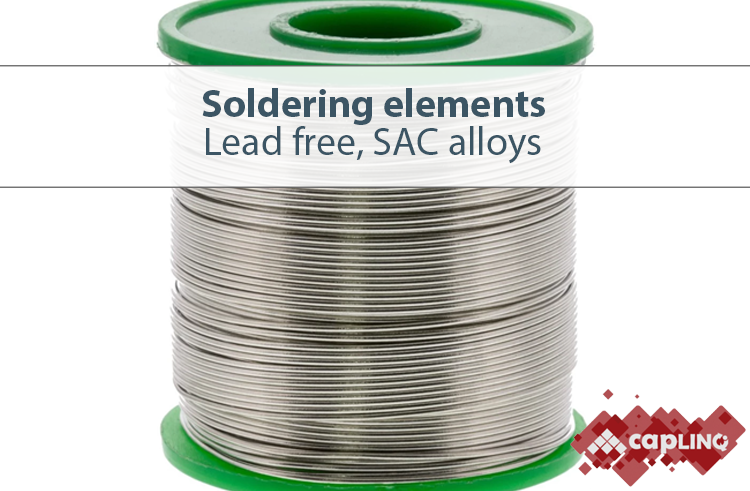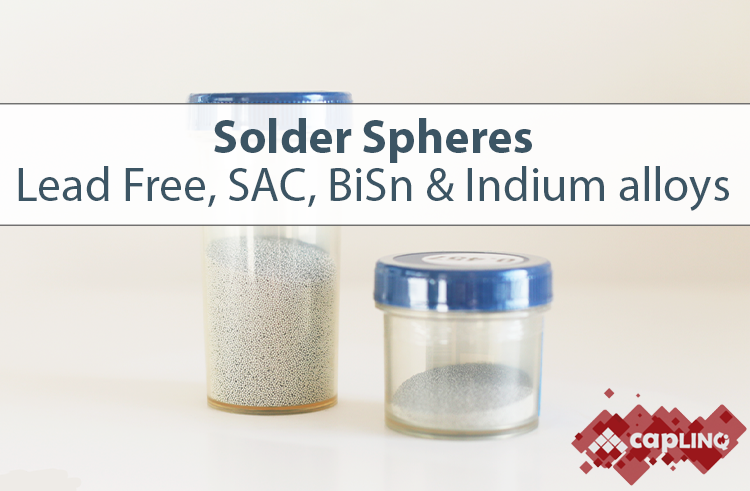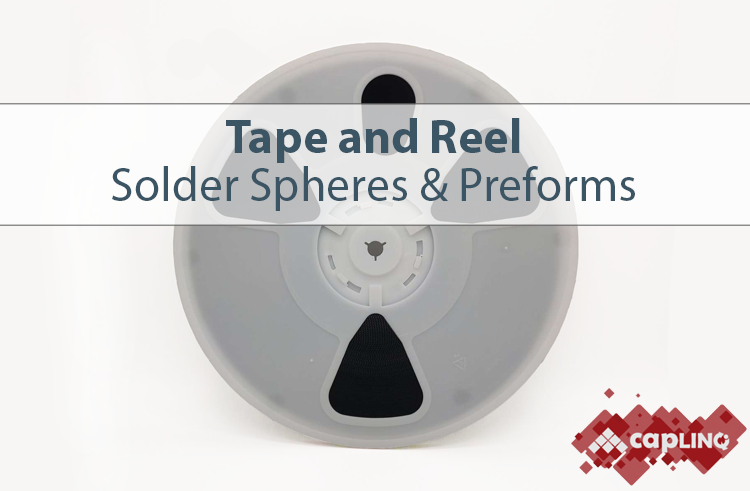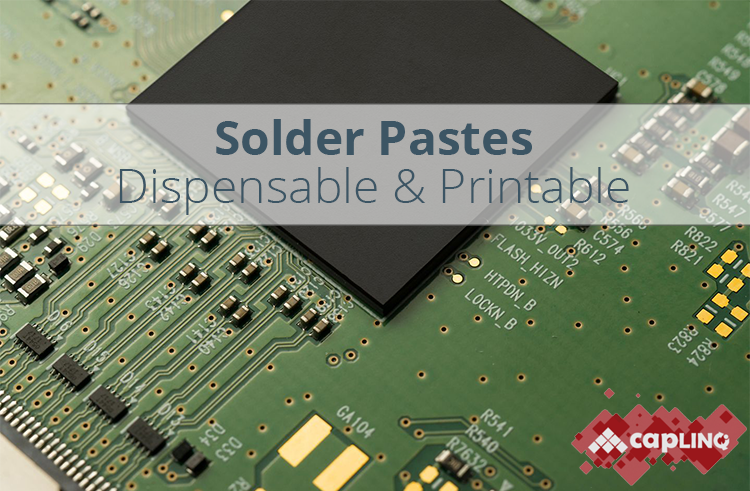Soldering Materials
Soldering materials cover a wide range of products such as solder spheres in jar or solder spheres on tape and reel, bonding wires, solder pastes, solder bar ans solder powders. We offer a wide range of alloys at some of the markets' best prices. Be sure to read this article to find out makes our high quality solder spheres so great. We offer not only a broad range of tin/lead and leadfree solder materials, but also offer the industry's widest range of solder ball diameters ranging from 60 micron to 890 micron (2.4 mil to 35 mil).
In addition to supplying the alloys and purifying the soldering material, we have an innovative diameter and spheroid selecting system of solder balls and an advanced anti-oxidation technology that actually dopes an anti-oxidation element into the alloy in addition to its OSP surface coating process. Not only are our solder spheres High-Tech, but they are made from a unique uniform droplet spraying technology that far outperforms competitors in terms of productivity. This combination of high technology and high productivity allow CAPLINQ to offer its customers the best value for the best product.
CAPLINQ maintains an inventory of many soldering material alloys and sizes, and we specialize in the fulfillment of small orders. This allows us to have low volume flexibility and also offer volume breaks and discounts for our higher volume customers. A complete list of sphere diameters, packaging quantities, volume breaks and discounts can be seen in the respective product categories. Can't find what you are looking for? Contact us for more information.
Frequently Asked Questions
Frequently asked questions about Soldering Materials
How does the soldering work?
Soldering is a joining process that unites metals by melting and flowing a filler metal (solder) into a joint. The solder, typically an alloy of tin and lead or tin and other metals, has a lower melting point than the base metals. When heated, the solder melts and forms a capillary action between the joined surfaces, creating a strong mechanical and electrical bond upon cooling. Flux is often used to prevent oxidation and improve solder flow.
What is a flux and it's primary purpose in soldering process?
Flux is a chemical substance essential to the soldering process. Its primary function is to prepare the metal surfaces to be joined by removing oxides and other contaminants. These oxides form naturally on metal surfaces and can prevent the solder from adhering properly, resulting in weak or unreliable joints. Its's key purposes are to prevent metal oxidation, to improve surface tension for improved wetting and enhance heat transfer between soldering iron and the joints to aid the melting solder.
What is a reflow profile?
A reflow profile is a carefully controlled temperature curve used in the surface mount technology (SMT) soldering process. It outlines the heating and cooling stages that a printed circuit board (PCB) assembly undergoes to achieve optimal solder joint formation.
Defining a reflow profile involves determining the optimal temperature, ramp rates, and soak times for each stage based on the solder paste, component sensitivity, and desired joint quality. Factors such as board design, component placement, and oven capabilities also influence the profile.
What Metals are used for soldering work?
Solder is typically an alloy of metals. Common solder alloys include tin-lead (SnPb), lead-free solder and other alloys for specific application. Tin-Lead (SnPb) is historically popular but restricted in many applications due to environmental concerns. Lead-free solder contains various combinations of tin, copper, silver, bismuth, and other metals to achieve desired melting points and mechanical properties. Examples include SnAgCu, SnCu, and SnBi. Other alloys are formulated for specific applications may require specialized solder alloys with unique properties, such as high-temperature or low-temperature solders.
The choice of solder metal depends on factors such as the base metals being joined, the application's requirements (electrical conductivity, mechanical strength, temperature resistance), and environmental regulations.
What are the types of soldering?
Soldering is primarily categorized based on the melting point temperature of the solder used.
1. Soft Soldering
- Uses solder alloys with a melting point below 450°C.
- Commonly used in electronics and plumbing.
- Offers good electrical conductivity and flexibility.
2. Hard Soldering
- Uses solder alloys with a melting point between 450°C and 840°C.
- Produces stronger joints compared to soft soldering.
- Commonly used in automotive and industrial applications.
3. Brazing
- Similar to hard soldering but uses filler metals with even higher melting points (above 840°C).
- Produces extremely strong and durable joints.
- Often used in aerospace and high-temperature applications.
Pb-Free Spheres SAC105, SAC125N SAC305, SAC387, SAC396, SAC405, SnAg or another alloy?
After many years of testing and debating, and with specific exceptions, the semiconductor industry has largely settled on the use of Tin (Sn), Silver(Ag), Copper(Cu) - or SAC - alloy for the assembly of lead free products. Although the SAC alloy has been settled, which SAC alloy to use is still up for debate. North American and Europe manufacturers favor SAC305 (Sn3.0Ag0.5Cu), while Asian manufacturers generally favor SAC405 (Sn3.8Ag0.8Cu).
What is the SAC alloy history?
SAC305 was first developed by Senju technology, who own the patents herefore. As such, manufacturers are required to pay a license to produce SAC305 which is built into the price charged to customers. SAC305 however has the benefit of being less expensive to produce than SAC405 owing to the lower silver content.
Having said that, studies indicate that there is no significant reliability difference between SAC305 and SAC405, and so CAPLINQ continue to support both SAC305 and SAC405.
Learn More
What is Soldering?
Soldering is not a new technology by any stretch of the imagination. It used to involve hammers, anvils and blacksmiths, heating up metals and pummeling them until they were welded together. But we've come a long way since then.
Solder pastes, solder preforms, solder spheres, solder bars and preforms are only some of the tools we have today to create connections regardless of substrate and temperature. From sealing and low temperature soldering to braze and high temperature applications, soldering materials and alloys cover the entire range.
The Soldering process is a critical process in electronics manufacturing, serving as the backbone for connecting electronic components to printed circuit boards (PCBs). Robust electrical conductivity, mechanical strength, and product durability are all ensured by a successful solder junction To achieve this, understanding the concept of solderability and the underlying mechanisms is essential. It is crucial to comprehend solderability and the underlying mechanics in order to accomplish this. It's influenced by surface cleanliness, oxide formation, and the material's metallurgical properties.
The soldering process involves melting a solder alloy and applying it to the joint between two surfaces. As the solder cools and solidifies, it forms a metallurgical bond with the base metals, creating a strong mechanical and electrical connection.

What is a Lead Solder?
Lead solder is a metallic alloy primarily composed of lead (Pb) and tin (Sn), often with small amounts of other elements like antimony (Sb) or copper (Cu). Historically, solder has been melted and solidified between the joined pieces using these alloys to unite metals. Compared to other metal alternatives, lead solder cools more slowly. This lessens the chance of the joint breaking and is effective in wetting joints. Lead solder has a lower and precise melting point, unlike many other metals. This makes it easier to control in the automated PCB assembly and less likely to damage electronic components during the soldering process.
What is a Lead-Free Solder?
Lead-free solder is a metallic alloy used for joining metals that do not contain lead (Pb). It's made without harmful lead and uses metals like tin, copper, silver, bismuth, or antimony. These alloys are designed to replace traditional lead-based solders due to the environmental and health concerns associated with lead.
Compared to lead-based solders, lead-free solders typically have higher melting temperatures, requiring adjustments in soldering processes. Lead-free solders often exhibit different mechanical properties, such as higher strength and hardness, compared to lead-based solders.
Some common lead-free combination includes Tin-Silver-Copper [SnAgCu] alloy, Tin-Copper [SnCu] alloy and Tin-Bismuth [SnBi] alloy. Choosing the right lead-free solder depends on the specific needs of the electronic product. Factors like component compatibility, thermal cycling requirements, and joint reliability need to be carefully considered when selecting a lead-free solder.
Important Soldering Material Properties
The properties of soldering materials significantly influence the quality and reliability of soldered joints. Here are some of the most important properties to consider when evaluating a soldering material:
Melting Point
The melting point is the temperature at which solder turns from solid to liquid. It influences the soldering process and the strength of the joint. Different types of solder have different melting points. The melting point must be lower than the melting point of the components being joined to prevent damage. Solder is classified as soft, hard, or brazing based on its melting range. The kind of metal in the solder determines its melting point. Some solders melt at a single exact temperature (eutectic), while others melt over a range of temperatures (non-eutectic).
Wetting Ability
Wetting ability is a critical property in soldering, referring to the solder's capacity to spread and adhere to the surfaces being joined. It's a measure of how well the molten solder wets the base metal, forming a uniform and cohesive joint.
Good wetting ensures a strong mechanical bond between the solder and the base metals, contributing to joint strength and reliability. Proper wetting promotes efficient electrical conductivity through the joint. Insufficient wetting can lead to various defects such as voids, solder balls, and insufficient fillet formation.
Wetting ability is often quantified by the contact angle, which is the angle formed between the solder and the solid surface. A lower contact angle indicates better wetting.

Alloy Composition
Alloy composition refers to the specific combination and proportions of elements within the solder alloy. The combination of elements in a solder alloy directly determines its melting point. The alloy composition affects the solder's strength, ductility, and fatigue resistance, influencing joint reliability. Different elements exhibit varying degrees of wetting behavior, impacting the solder's ability to adhere to the base metal. The composition of a solder alloy influences its electrical conductivity, which is crucial for electronic applications. Certain elements in the alloy can enhance or reduce the solder's resistance to corrosion. Common lead-free solder types include SnAgCu (tin-silver-copper), SnCu (tin-copper), and SnBi (tin-bismuth).
Viscosity
Viscosity refers to a fluid's resistance to flow. In the context of soldering, it's crucial to determine how easily the molten solder flows and spreads across the joint. Viscosity is critical for printing accuracy, stenciling, and deposit volume for solder paste. A suitable viscosity ensures consistent solder deposition without defects like bridging or solder balls. Lower viscosity allows for better wetting and joint formation. The type and amount of vehicle, binder, and other additives influence the solder paste's viscosity. In conclusion, viscosity is a crucial property that impacts the overall quality and reliability of soldered joints.
Oxidation Resistance
Oxidation resistance refers to a solder material's ability to resist forming an oxide layer on its surface when exposed to high temperatures during the soldering process. An oxide layer can hinder the solder's ability to wet the base metal, leading to poor joint formation and reduced reliability. Oxide formation prevents proper wetting, resulting in poor solder adhesion and weak joints. Oxide layers can increase electrical resistance within the joint. Certain elements in the solder alloy exhibit better oxidation resistance than others. For example, silver and copper can help to reduce oxidation. The flux used in soldering plays a crucial role in removing oxides from the base metal surfaces and preventing re-oxidation. The presence of oxygen or other reactive gases can accelerate oxidation.
Electrical Conductivity
Electrical conductivity is a crucial property of soldering materials, as it directly affects the ability of a solder joint to conduct electricity efficiently. It's a measure of how well a material can transmit electric current. High electrical conductivity ensures minimal signal loss and distortion, crucial for high-frequency applications. For power electronics, good conductivity is essential to prevent excessive heat generation and voltage drops. Poor electrical conductivity can lead to device malfunction, overheating, and reduced lifespan.
The quality of the solder joint, including wetting, intermetallic compound formation, and void presence, affects conductivity. Contaminants in the solder or on the base metal surfaces can increase electrical resistance.
Thermal Conductivity
Thermal conductivity is a measure of a material's ability to conduct heat. In the context of soldering, it refers to how efficiently a solder joint can transfer heat. In electronic components, heat generation is inevitable. A solder joint with good thermal conductivity helps to dissipate heat effectively, preventing overheating and component failure. Efficient heat transfer contributes to the overall reliability of electronic assemblies by reducing thermal stress on components. For high-power devices, thermal conductivity is crucial to maintain optimal performance and prevent thermal throttling.
Different elements in the solder alloy have varying thermal conductivities. The presence of voids, intermetallic compounds, or impurities within the solder joint can reduce thermal conductivity. The thickness and shape of the solder joint influence heat transfer.
Mechanical Strength
Mechanical strength refers to a solder joint's ability to withstand physical forces without failure. It's a critical property that ensures the longevity and reliability of electronic assemblies. A strong solder joint prevents fractures, cracks, or delamination under mechanical stress.
Some examples of measures involving mechanical strength are hardness and tensile strength. Hardness can be a useful indicator of a solder joint's resistance to scratching, wear, and localized deformation. Tensile strength is a critical parameter for evaluating solder joint strength. It provides information about the joint's ability to resist breaking under pulling forces. Factors like hardness and tensile strength are measured to assess joint quality, but they don't fully capture real-world conditions.
Soldering Alloys
Alloy Composition | Melting Point (°C) | Attributes and Comments |
Lead-Based Solder Alloys | ||
Mid Temp | ||
Sn63Pb37 | 183 | Low copper erosion and Non-corrosive, excellent wetting, good electrical conductivity, |
Sn62Pb36Ag2 | 180 [Liquidus] 178 [Solidus] | Good wetting, excellent electrical conductivity |
Sn60Pb40 | 183 [Solidus] 190 [Liquidus] | Good wetting, excellent electrical conductivity |
Low Temp | ||
Sn37Pb58Bi5 | 138 | Very low melting point, good wetting, cost-effective (Lower Tin content) |
Lead-Free Solder Alloys | ||
Sn96.5Ag3.0Cu0.5 | 217 [Liquidus] 220 [Solidus] | Good mechanical properties (higher tensile strength), Reliable, Most widely used lead-free solder alloy |
Sn97Cu3 | 227 | Good thermal conductivity, cost-effective, Recommended for wave soldering application. Lower ductility compared to SnAgCu |
Sn99.3Cu0.7 | 227 | Good thermal conductivity, cost-effective. Lower ductility compared to SnAgCu |
Component Mounting Process
Component mounting is the process of attaching electronic components to a printed circuit board (PCB) using solder to create electrical connections. This crucial step transforms a bare PCB into a functional electronic product. There are two primary methods for component mounting, Surface Mount Technology (SMT) and Through-Hole Technology (THT).
Surface Mount Technology (SMT)
Components are placed directly onto the PCB's surface and soldered using a reflow process.

Through-Hole Technology (THT)
Components have leads that are inserted through holes in the PCB and soldered in place, typically using wave soldering.
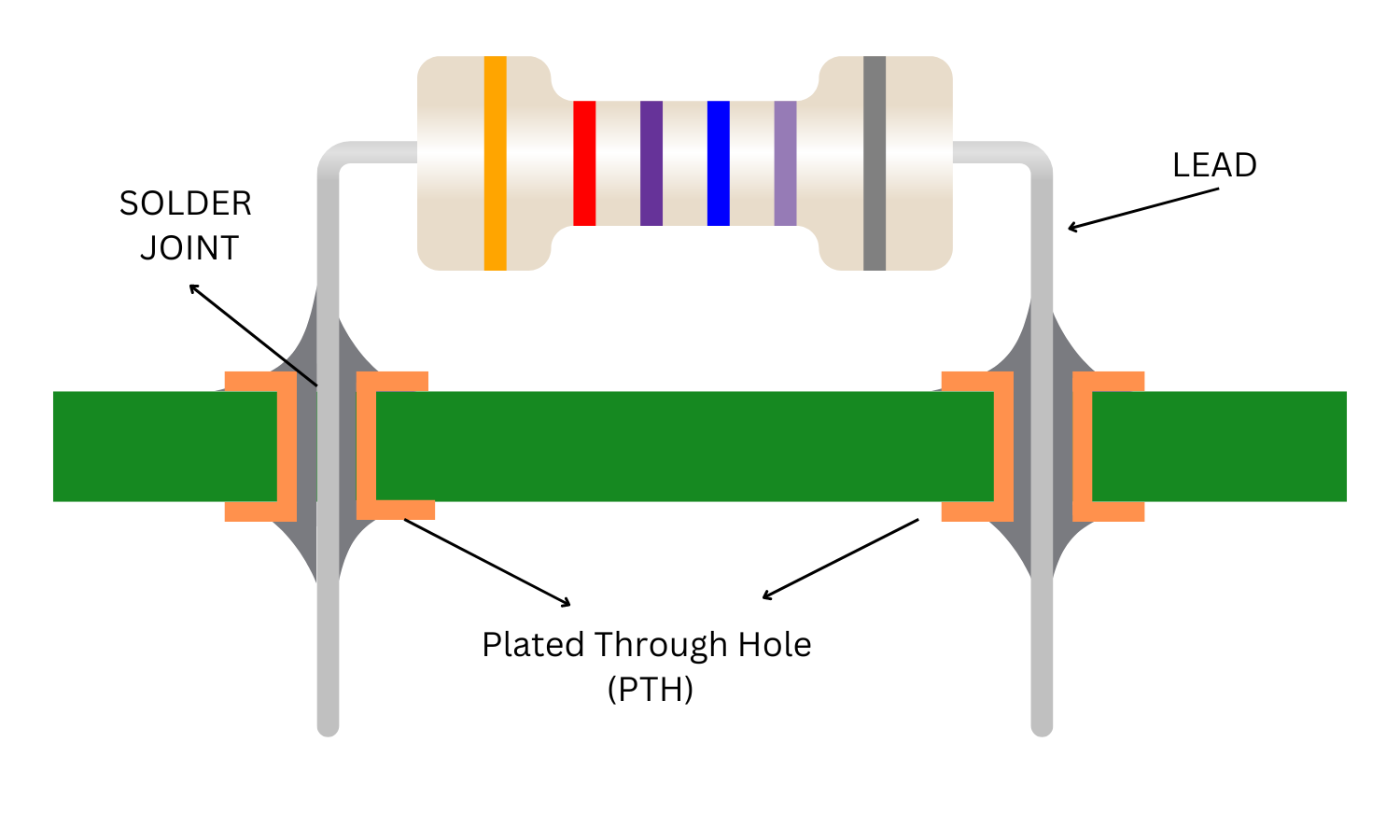
Type of component mounting | Advantages | Disadvantages |
Surface Mount Technology (SMT) |
|
|
Through- Hole Technology (THT) |
|
|



